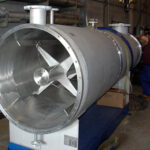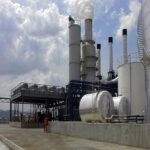- Home
- portfolio
- Thermal Evaporators
- FORCED CIRCULATION EVAPORATOR
FORCED CIRCULATION EVAPORATOR
THERMAL EVAPORATORS
Evaporator is the name which itself describes the process equipment used to remove liquid by vaporization. In the evaporation process, concentration of a product is achieved by boiling out a water (solvent). The feed material may be a single liquid, liquid mixture, solutions or slurries, or any combination of these. Heat applied through some form through a heat transfer surface is used to produce the vaporization. The concentrated product, as discharged, is still in fluid, pump-able form.
It is a unit operation that is used extensively in processing foods, chemicals, pharmaceuticals, fruit juices, dairy products, paper and pulp, malt and grain beverages, effluents, biotechnological nutraceuticals, polymers and resins, inorganic salts, acids, bases, etc.
There are many types and variations of evaporators, and the best for a particular application depends on the product characteristics and desired results.
Evaporators can be classified in several ways:
- a) by tube position: horizontal or vertical
- b) by tube length: short or long
- c) by the direction of movement of film: rising or falling
- d) by the number of evaporators or effects. Like Multi-Effect Evaporator (MEE)
Evaporators can either work on a batch or a continuous basis. They can be designed to facilitate heat recovery (in single-stage plants by preheating installations or multistage plants by using the vapour from one stage to heat the following stage). For this purpose, the vapour is either compressed with new fresh steam or compressed mechanically. Compressed vapour (with higher enthalpy and higher temperature) is fed to the evaporator, where residual heat is used to preheat solution.
Batch-wise operating plants are used in cases where only a small amount of water is to be removed or other ingredients are to be added during the concentration, as they might have a defined dry matter level in the finished product.
Large plants are generally installed with continuous evaporators.
Evaporator installations can be either single-stage or multistage. A single-stage evaporator is a closed unit with a defined pressure and corresponding temperature. In multistage plants (up to seven stages), product from the first stage is transferred into the second stage and is heated with vapour from the first stage to the boiling point.
Typical desired results from an Efficient Evaporator
- Product concentration for further use in process or formulations
- Dryer feed pre-concentration, for lowering operation cost for Drying.
- Volume reduction for feeding to further drying in case of disposal for land filling.
- Water / solvent recovery.
- Crystallization
RAYGM supplies variety of evaporator like
- Falling film Evaporators (FFE)
- Rising Film Evaporator (RFE)
- Forced Circulation Evaporator (FCE)
- Agitated Thin Film Evaporator (ATFE)
- Multieffect Evaporators (MEE)
HOW TO SELECT AN EFFICIENT EVAPORATOR FOR YOUR APPLICATION:
WHILE SELECTING AN EVAPORATOR FOLLOWING THINGS ARE TO BE CONSIDERED.
1 STEADY STATE CONDITIONS
From the mass and energy balance equations, liquid–vapor equilibrium equation and specific relations for the product (slurry) to be evaporated, a steady state model for the evaporator system should be developed, considering one up to seven effects. From this information, it is possible to verify the decrease in vapor flowrate necessary for the operational process and an increase in the total system area, when augmenting the number of effects.
2 RETENTION OF KEY INGREDIENT
Key Ingredient retention in the final product should be estimated for each one of the alternative systems from the data obtained under steady state operation. When augmenting the number of effects in the evaporation system the retention of key ingredient may or may not be a function of the residence time in the evaporation system. While the number of effects increase in the evaporation system, the total residence time increases as well as the temperature at which the product is exposed, and, therefore, there is also a chance for key ingredient variation or degradation, should be avoided.
3 ECONOMIC EVALUATION
The economic evaluation consists of determining the optimum number of effects and operating conditions of the system. The economic evaluation of the system should be done in two different ways. Firstly, an economic evaluation with the concept of minimizing the total (capital + operation) costs, and secondly, an economic evaluation to maximize the NPV (Net Present Value) considering the impact of the process design and operating conditions on product quality, fouling of Calandrias, CIP time requirement, CIP Chemicals disposal cost, increase in effluent load on ETP etc.
4 OPTIMUM OPERATING CONDITIONS
In the search for the optimum operating conditions of evaporation system, the system should be economically evaluated under a variable steam inlet pressure where the inclusion of key ingredient concentration as a quality parameter should be considered.
5 OPTIMUM NUMBER OF EFFECTS
The economic evaluation should be carried out by simple calculations. This is where the steady state conditions for systems with 1–7 effects are generally found, and then total cost minimization and NPV maximization methodologies were used. The search should be focused to find the number of effects that minimize the total cost and, in addition, to find the number of effects that maximize the NPV.
Evaporator Selection Based on Product characteristics and or Capacity
Type of Evaporator
Clean
Foaming
Viscous
Fouling
High Capacity
Temp. Sensitive
Solids or Crystals
Rising Film
X
X
X
Rising Film
X
X
X
X
X
Forced Circulation
X
X
X
X
X
X
Agitated Thin Film
X
X
X
X
X
X
X
A properly designed evaporator shall be, at a minimum:
- Shall be designed to effectively transfer heat at a high heat flux with minimum surface area to be cost-effective for installation (Capital Cost), Operations and maintenance.
- Shall Effectively separate the vapor from the liquid concentrate and generate maximum quantity of flash vapours to use in next effects, lowering operation cost.
- Meet the conditions required by the product being processed, for e.g. reduction of effluent, concentration of product for feeding to dryer for minimizing drying cost.
- Shall Produce a product that meets the required quality of the product in terms of retention of Key Ingredients, Aroma etc.
- Shall Be energy efficient, where possible making effective use of steam with multiple-effect evaporation or vapor recompression.
- Minimize fouling of heat transfer surfaces
- Be constructed of materials that are adequate to minimize corrosion and give long life of the equipment.
FORCED CIRCULATION EVAPORATOR
The feed liquid is fed into the circulating stream which is moved by a pump through a Calandria and a vapour separator vessel. The heat applied through the tube walls superheats the liquid which flashes into the vapour separator and vapours are separated from the concentrated liquid. The high velocity of the liquid effects good heat transfer values but requires a large circulation pump. Further, the high velocity reduces the tendency for fouling and scaling.
THE FORCED CIRCULATION EVAPORATOR’S ADVANTAGES ARE
- High rate of heat transfer;
- Positive circulation;
- Relative freedom from salting, scaling, and fouling;
- Ease of cleaning;
- Wide range of application.
- Best suited when treating crystalline products, corrosive products, or viscous fluids.
- Suited for vacuum service, and for applications requiring a high degree of concentration and close control of bottoms product concentration.
THE FORCED CIRCULATION EVAPORATOR’S ADVANTAGES ARE
Some of the Applications in which forced circulation is used includes urea, sodium sulfate, sodium chloride, magnesium chloride, caustic potash, citric acid, and ammonium sulfate.



